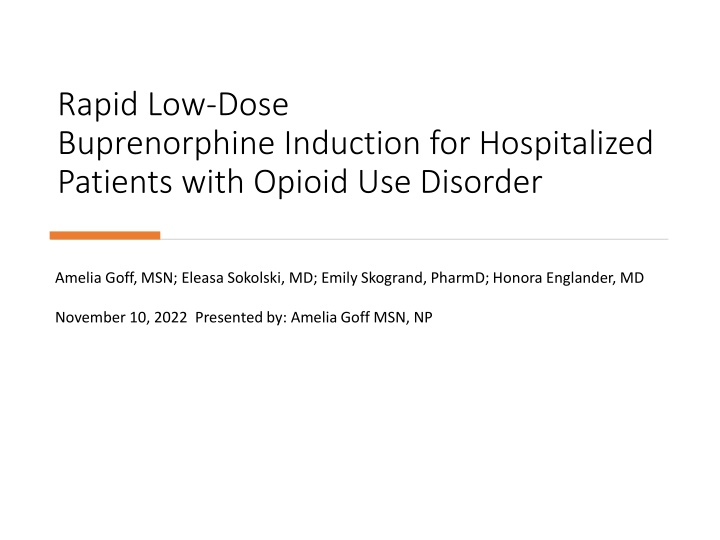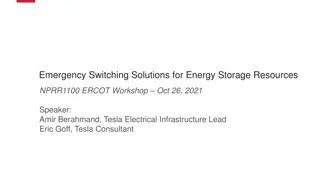
Rapid Low-Dose Buprenorphine Induction in Hospitalized Patients with Opioid Use Disorder
Learn about the rapid low-dose buprenorphine induction for hospitalized patients with opioid use disorder. This method allows for quicker initiation and aims to address barriers like acute pain and anxiety. The protocol aims to reach therapeutic doses in 3-5 days and increase equitable access to medication-assisted treatment.
Download Presentation

Please find below an Image/Link to download the presentation.
The content on the website is provided AS IS for your information and personal use only. It may not be sold, licensed, or shared on other websites without obtaining consent from the author. If you encounter any issues during the download, it is possible that the publisher has removed the file from their server.
You are allowed to download the files provided on this website for personal or commercial use, subject to the condition that they are used lawfully. All files are the property of their respective owners.
The content on the website is provided AS IS for your information and personal use only. It may not be sold, licensed, or shared on other websites without obtaining consent from the author.
E N D
Presentation Transcript
Rapid Low-Dose Buprenorphine Induction for Hospitalized Patients with Opioid Use Disorder Amelia Goff, MSN; Eleasa Sokolski, MD; Emily Skogrand, PharmD; Honora Englander, MD November 10, 2022 Presented by: AmeliaGoff MSN, NP
Disclosures Amelia Goff has no disclosures
Background Barriers to traditional buprenorphine initiation in hospitalized patients with opioid use disorder (OUD) include acute pain, anxiety, or fear of precipitated withdrawal Low-dose buprenorphine initiation (sometimes referred to as microinduction ) allows patients to start buprenorphine while continuing full-agonist opioids Most low-dose protocols require 7-10 days to complete - limiting feasibility in hospitalized patients with shorter or unpredictable lengths of stay Button, JAM 2022; Cohen, JAM 2021
Background Several protocols have been developed for more rapid initiation to reach therapeutic doses in 3-5 days Given buprenorphine s rapid one-hour time to peak plasma concentration, low doses can be given up to every 3 hours without precipitating withdrawal Published experience of rapid low-dose buprenorphine initiation over 3-5 days is limited to small case reports or series, with few examples in hospital settings Wong, Addict Sci Clin Pract 2021; Klaire, Am J Addict 2019; Azar, Am J Addict 2020; Chiang, J Substance Abuse Treatment 2003.
Background Black, Indigenous and Latinx patients are less likely than white patients to access buprenorphine Significant disparities persist in hospital SUD care Offering hospitalized patients buprenorphine induction without withdrawal and with sufficient pain control opportunity to increase equitable, trauma-informed access to MOUD Priest, Substance Abuse 2022; SAMSHA 2020; Peterkin, J Addict Med 2022; Lagisetty, JAMA Psychiatry 2019; Chang, J Substance Abuse Treatment 2022
Objectives We describe our first 6 months experience initiating buprenorphine via rapid low-dose induction (completed over 72 hours) among hospitalized adults with opioid use disorder (OUD)
Methods Retrospective cohort study of patients with OUD, seen by an interprofessional addiction medicine consult service (IMPACT) at a single academic medical center Patients admitted to general hospital, started buprenorphine via a rapid low-dose initiation between November 2021 and May 2022 Prospectively tracked patients using an electronic registry and abstracted outcomes from electronic health record Reasons for pursuing a more rapid initiation: anticipated hospital discharge in <7 days patient preference
Methods Considered initiation complete once patients received first 8mg dose of buprenorphine Chose as completion target, as lower doses are unlikely to provide adequate opioid receptor blockade to alleviate withdrawal in most patients. Patients could receive additional buprenorphine doses as needed for opioid cravings or withdrawal up to 24mg. Defined precipitated withdrawal as new onset or worsening of nausea, body aches, restlessness, anxiety, or rhinorrhea within 2 hours of receiving buprenorphine.
Limitations Small study at single academic medical center with robust interprofessional addiction consult service Experience may not be generalizable to hospitals without addiction expertise Most participants were white, male Relied on patient report rather than urine drug testing to evaluate use of illicit fentanyl Did not intend to compare rapid low-dose initiation to other strategies
Implications Finding that no patients had precipitated withdrawal and many reported illicit fentanyl use suggests that this approach may be feasible, safe alternative in hospitalized patients, many of whom use fentanyl Finding that 79% completed induction within 90 hours holds particular importance for patients with anticipated shorter hospital length of stay Including patients admitted for active labor or high-risk pregnancy Chiang, J Substance Abuse Treatment 2003.
Conclusions Rapid low-dose buprenorphine initiation in hospitalized patients is a feasible and well-tolerated alternative to traditional and slower low-dose initiations May benefit obstetrics patients, given average 48-72 hour post-partum hospital stay May be benefit patients who use fentanyl, given higher risk for precipitated withdrawal Provides a practical way to start buprenorphine for patients with unpredictable or short hospital stays Chiang, J Substance Abuse Treatment 2003; Varshneya, J Addict Med 2021
Thank you Collaborators: Honora Englander, MD Eleasa Sokolski, MD Emily Skogrand, PharmD Dana Button, MD Alisa Patten, MA IMPACT multi-disciplinary team
References 1. Azar P, Wong JSH, Jassemi S, et al. A Case Report: Rapid Micro-Induction of Buprenorphine/Naloxone to Administer Buprenorphine Extended-Release in an Adolescent With Severe Opioid Use Disorder. Am J Addict. Nov 2020;29(6):531-535. 2. Button D, Hartley J, Robbins J, Levander XA, Smith NJ, Englander H. Low-dose Buprenorphine Initiation in Hospitalized Adults With Opioid Use Disorder: A Retrospective Cohort Analysis. J Addict Med. Mar-Apr 01 2022;16(2):e105-e111. 3. Chang JE, Franz B, Cronin C, LindenfeldZ, Lai AY. Racial/ethnic disparities in the availability of hospital based opioid use disorder treatment. Journal of Substance Abuse Treatment, Volume 138, 108719 4. Chiang CN, Hawks RL. Pharmacokinetics of the combination tablet of buprenorphine and naloxone. Drug Alcohol Depend. May 21 2003;70(2 Suppl):S39-47. 5. Englander H, Weimer M, Solotaroff R, et al. Planning and Designing the Improving Addiction Care Team (IMPACT) for Hospitalized Adults with Substance Use Disorder. J Hosp Med. May 2017;12(5):339-342. 6. Hjelmstr m P, Banke NordbeckE, Tiberg F. Optimal dose of buprenorphine in opioid use disorder treatment: a review of pharmacodynamic and efficacy data. Drug Dev Ind Pharm. Jan 2020;46(1):1-7. 7. Klaire S, Zivanovic R, Barbic SP, Sandhu R, Mathew N, Azar P. Rapid micro-induction of buprenorphine/naloxone for opioid use disorder in an inpatient setting: A case series. Am J Addict. Jul 2019;28(4):262-265.
References 8. Lagisetty PA, Ross R, Bohnert A, Clay M, Maust DT. Buprenorphine Treatment Divide by Race/Ethnicity and Payment. JAMA Psychiatry. Sep 1 2019;76(9):979-981. doi:10.1001/jamapsychiatry.2019.0876 9. Peterkin A, Davis CS, Weinstein Z. Permanent Methadone Treatment Reform Needed to Combat the Opioid Crisis and Structural Racism. J Addict Med. Mar-Apr 01 2022;16(2):127-129. doi:10.1097/adm.0000000000000841 10. Priest KC, King CA, Englander H, Lovejoy TI, McCarty D. Differences in the delivery of medications for opioid use disorder during hospitalization by racial categories: A retrospective cohort analysis. Substance Abuse. 2022/12/01 2022;43(1):1251-1259. doi:10.1080/08897077.2022.2074601 11. SAMHSA. Double jeopardy: COVID 19 and behavioral health disparities for Black and Latino communities in the US. 2020. Available from: https://www.samhsa.gov/sites/default/files/covid19-behavioral-health- disparities-black-latino-communities.pdf. (Accessed Oct 15, 2022) 12. Varshneya NB, Thakrar AP, Hobelmann JG, Dunn KE, Huhn AS. Evidence of Buprenorphine-precipitated Withdrawal in Persons Who Use Fentanyl. J Addict Med. Nov 23 2021 13. Wong JSH, NikooM, Westenberg JN, et al. Comparing rapid micro-induction and standard induction of buprenorphine/naloxone for treatment of opioid use disorder: protocol for an open-label, parallel- group, superiority, randomized controlled trial. Addict Sci Clin Pract. Feb 12 2021;16(1):11.

